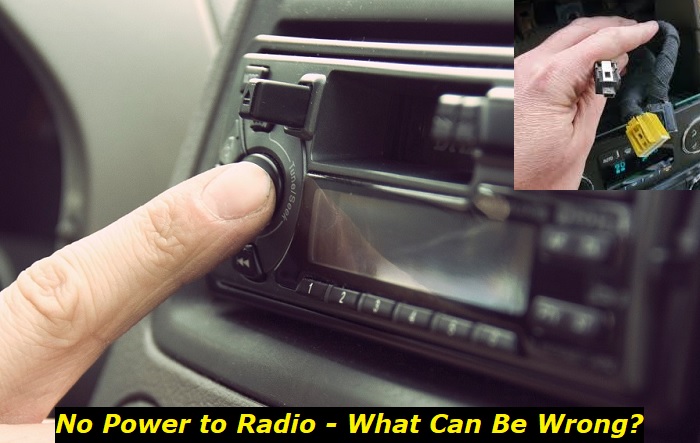Listening to the radio has become part and parcel of driving for so many people. Would a car ride be any good without the sound of the radio accompanying you? For some, the radio's sound makes long drives pleasant and hold-ups tolerable. Sometimes, drivers sit in their cars with the engines turned off, eyes closed, and listen to the radio. Despite not being a part that is essential for a vehicle to move, the radio is quite important to many drivers.
Music problems highlights
- Reasons:power supply, software, radio issues
- Quick fix:check the fuses and wiring
- Price forrepair:$50 - $350
- Time forrepair:0.5 - 1.5 hours
- Howcommon:not that common
- DIYrepair:possible

Dead Car Battery
The car battery is what powers most electrical components within the car, including the radio.
If the ignition is on, turning on the car radio without starting the engine is possible. So, if the battery is dead or drained, and you try to power the radio with the ignition on, it will not work.
You can find out if a dead battery is why your radio is not turning on by trying to ignite the engine. A drained battery will also prevent the engine from starting. Hence if the engine fails to start, it is likely that the battery is not working.
To confirm, test other electrical components that need the battery to turn on, such as the lights. If the battery is dead, those components will not work. The battery can drain if you accidentally leave the lights or other electrical components on for a long time. The battery may also drain because the alternator recharging the battery is malfunctioning. If either is the case, recharging the battery or fixing the alternator could be what you need.
Yet, it is also possible that the battery is completely damaged and needs replacement.
Power Button
The reason the radio is not turning on could very well be because the button that you need to power it on got damaged. To test for this, you must find an alternative means of turning on the radio. Consult your manual or research online about other ways to start your car's factory-equipped or aftermarket radio. For instance, some car radios allow you to switch them on using infrared remote controls.
Detached Pigtail connector
A detached or loosely attached pigtail connection will prevent the car radio from powering up. We must check for looseness in the pigtail connection to the head unit. To check the pigtail connector:
- Remove the head unit to access the wiring.
- After removing it, inspect the pigtail connector to see if it fits tightly into the head unit.
- If that does not work, try disconnecting the pigtail from the head unit and reconnecting it afterward.
- Ensure the pigtail makes solid electrical contact.
- Try to power on the radio again.
Wiring issues
Besides the pigtail connector, other wires are necessary to send power to the radio. The radio may not come on if there is a wiring problem.
Due to car vibrations and bumps, mishandling during aftermarket installations, or other repairs, it is possible for the wiring that supplies power to the radio from the battery to become loose. A loose connection to the cables providing power to the radio would not allow power to reach the unit.
Also, suppose you have recently installed an aftermarket radio which is not powering on. In that case, its wiring requirements may differ from the stock radio. So, when installing an aftermarket radio, consult the manual to be sure the correct wires are connected.
Faulty Head Unit Wires
Checking the power wires connected to the head unit is wise if you have not pinpointed the issue yet. Usually, a head unit has three power wires; a constant wire (yellow), an accessory or ignition wire (red), and a ground wire (usually black). Because of its "memory keep-alive" function, the constant power wire is always hot and will have 12 volts running through it.
The ignition wire will be hot and carry 12 volts only if you turn on the ignition. The ignition wire prevents the radio from coming on when the ignition is off. Lastly, the ground wire is a safety measure to prevent excess electricity from damaging the system.
We can test the functional state of these wires with a digital multimeter. The digital multimeter should read at least 12 volts from the constant wire with the car off. The multimeter should read 0 volts from the ignition wire when the ignition is off. But, with the ignition turned on, it should read at least 12 volts.
Suppose the voltage read by the multimeter is as described. In that case, this means the power wires connected to the head unit are not the reason the radio does not power on. Otherwise, if the values you get are different, you might have found why your radio is not working.
We can examine the ground wire for issues if the multimeter is not reading 12 volts on either or both the constant and ignition wires. To test the ground wire:
- Put the multimeter's black probe on any metal within the car, with the metal serving as a grounding point.
- Use the other probe to test both power wires with the ignition on. The ground wire is faulty if the digital multimeter reads at least 12 volts for each of the other power connections.
- If this is the case, check for corrosion on the ground wire.
- In addition, make sure the ground wire connects to the pigtail connector.
If the ground wire is faulty, either the wire has become loose, or you need more suitable grounding for insulation.
Anti-theft protection
Some head units have built-in security or anti-theft protection modes that stop the head unit or radio from working if stolen. This anti-theft measure becomes active if something interrupts power to the head unit. For example, disconnecting the battery may trigger this mode.
A factory-fitted head unit or radio is likelier to have this feature than an aftermarket unit. Before checking if this is the problem, check your car manual or research your model online to confirm the radio has anti-theft protection. Consider the next issue and save time if your radio or head unit does not have built-in anti-theft protection.
Some head units with anti-theft protection will still turn on but not operate. The head unit will display an error message or code in such a case. However, some other anti-theft modes will disable the unit from completely working. Either way, you will need to perform an instruction detailed by the manufacturer to fix the error. For instance, you might need to enter a particular code to solve the problem. To be sure of what to do, consult your manual.
Bad Radio
We might have bad news if you have gotten this far without figuring out why the radio will not power on.
If the fuses related to the radio are healthy, the pigtail connection is fine, the power lines are in check, your car's battery is functioning, and anti-theft mode is not present or is not activated, you might have a damaged radio or head unit. But we shouldn't rush to this conclusion.
We can confirm if the radio is faulty by performing a bench test. Bench testing will involve connecting the radio directly to a 12-volt to 13.8-volt DC power supply. In this case, your car battery will do. Insulate all exposed wires before doing this test. Also, ensure the radio's metal parts do not come in contact with the battery to prevent a short circuit. To test if the radio is damaged:
- Use jumpers or clamps to connect the ignition and constant wire to the positive terminal of your car battery. The jumpers or clamps will hold the wires in place.
- Connect the ground wire to the battery's negative terminal with jumpers or clamps.
- Try turning on the radio.
If the radio comes on, then the reason the radio was not coming on may lie elsewhere. Taking the car to the nearest service center for further inspection is the most appropriate action at this juncture. But, if the radio fails to turn on during the bench test, it is faulty and needs fixing or replacement. For this, we also recommend getting the help of an expert.
Conclusion
Losing access to your car radio can be frustrating. This is especially true if you are the type of driver with the habit of listening to it when in the vehicle. Even worse is if the problem is not because of a blown fuse, as that would have been an easy and cheap fix. Before you give up and go to the mechanic, look at some of the possible reasons we have outlined above. Then, see if you can solve the issue.
Consult a nearby auto dealer or mechanic if you cannot fix the "no power to radio issue" or find the tests too complex.
About the authors
The CarAraC research team is composed of seasoned auto mechanics and automotive industry professionals, including individuals with advanced degrees and certifications in their field. Our team members boast prestigious credentials, reflecting their extensive knowledge and skills. These qualifications include: IMI: Institute of the Motor Industry, ASE-Certified Master Automobile Technicians; Coventry University, Graduate of MA in Automotive Journalism; Politecnico di Torino, Italy, MS Automotive Engineering; Ss. Cyril and Methodius University in Skopje, Mechanical University in Skopje; TOC Automotive College; DHA Suffa University, Department of Mechanical Engineering






Add comment